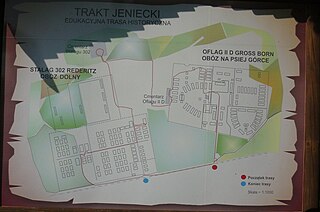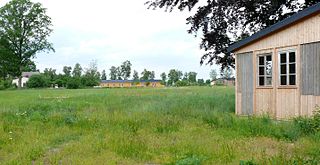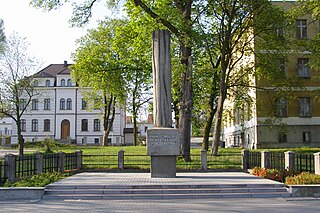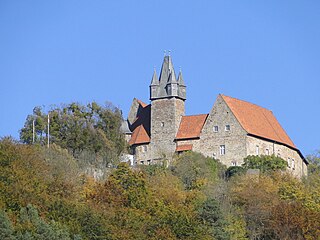
Oflag II-D Gross Born (Grossborn-Westfalenhof) was a World War II German prisoner-of-war camp located at Gross Born, Pomerania, near Westfalenhof (Kłomino). It housed Polish and French officers.

Oflag XIII-B was a German Army World War II prisoner-of-war camp for officers (Offizierslager), originally in the Langwasser district of Nuremberg. In 1943 it was moved to a site 3 km (1.9 mi) south of the town of Hammelburg in Lower Franconia, Bavaria, Germany.
Oflag IX-C was a German prisoner-of-war camp for officers (Offizierlager) during World War II, located just to the south of the village of Molsdorf, near Erfurt in Thuringia.
Oflag VII-B was a World War II German prisoner-of-war camp for officers (Offizierlager), located in Eichstätt, Bavaria, about 100 km (62 mi) north of Munich.
Oflag X-B was a World War II German prisoner-of-war camp for officers (Offizierlager) located in Nienburg/Weser, Lower Saxony, in north-western Germany. Adjacent to it was the enlisted men's camp (Stammlager) Stalag X-C.

Stalag VII-A was the largest prisoner-of-war camp in Nazi Germany during World War II, located just north of the town of Moosburg in southern Bavaria. The camp covered an area of 35 hectares. It served also as a transit camp through which prisoners, including officers, were processed on their way to other camps. At some time during the war, prisoners from every nation fighting against Germany passed through it. At the time of its liberation on 29 April 1945, there were 76,248 prisoners in the main camp and 40,000 or more in Arbeitskommando working in factories, repairing railroads or on farms.

Stalag X-B was a World War II German prisoner-of-war camp located near Sandbostel in Lower Saxony in north-western Germany. Between 1939 and 1945 several hundred thousand POWs of 55 nations passed through the camp. Due to the bad conditions in which they were housed, thousands died there of hunger, disease, or were killed by the guards. Estimates of the number of dead range from 8,000 to 50,000.

Camp Fünfeichen was a World War II German prisoner-of-war camp located in Fünfeichen, a former estate within the city limits of Neubrandenburg, Mecklenburg, northern Germany. Built as Stalag II-A Neubrandenburg in 1939, it was extended by the officer camp Oflag II-E in 1940. After the Soviet takeover in 1945 until 1949 it was used as special camp, NKVD-camp Nr. 9 of the Soviet secret service (NKVD). Today, the site of the camp is a memorial.

Oflag II-C Woldenburg was a German World War II prisoner-of-war camp located about 1 kilometre (0.62 mi) from the town of Woldenberg, Brandenburg. The camp housed Polish officers and orderlies and had an area of 25 hectares with 25 brick huts for prisoners and another six for kitchens, class-rooms, theater, and administration. Now it houses a museum.

Oflag IV-D was a World War II German Army prisoner-of-war camp located in Elsterhorst near Hoyerswerda, then part of Lower Silesia, 44 km (27 mi) north-east of Dresden. It held mostly French, but also Belgian, Polish, Serbian, British and other Allied officers.

Oflag X-C was a German World War II prisoner-of-war camp for officers (Offizierlager) in Lübeck in northern Germany. The camp was located on the corner of Friedhofsallee and Vorwerkstrasse, close to Lübeck's border with the town of Schwartau, and is often cited as being located in Schwartau rather than Lübeck. It housed French, British, Polish and other Allied officers.

Oflag VII-C was a World War II German prisoner-of-war camp for officers located in Laufen Castle, in Laufen in south-eastern Bavaria from 1940 to 1942. Most of the prisoners were British officers captured during the Battle of France in 1940. To relieve overcrowding, some of the officers were transferred to Oflag VII-C/Z in Tittmoning Castle. The Oflag existed only for a short time. In early 1942 all the officers were transferred to Oflag VII-B in Eichstätt.
Stalag XIII-D Nürnberg Langwasser was a German Army World War II prisoner-of-war camp built on what had been the Nazi party rally grounds in Nuremberg, northern Bavaria.
Oflag XIII-A, Oflag XIII-B and Oflag XIII-D were all German World War II prisoner-of-war camp for officers (Offizierlager). They were all located on the old Nazi party rally grounds in Langwasser, Nuremberg, in northern Bavaria. They were adjacent to Stalag XIII-D.

The Capture of Hamburg was one of the last battles of the Second World War, where the remaining troops of the German 1st Parachute Army fought the British XII Corps in Lower Saxony for the control of Hamburg, Germany, between 18 April and 3 May 1945. British troops were met with fierce resistance when they advanced toward the city as Hamburg was the last remaining pocket of resistance in the north. Once the British had captured the city, they continued their advance north-east and sealed off the remnants of the 1st Parachute Army and Army Group Northwest in the Jutland peninsula.
Stalag XIII-C was a German Army World War II prisoner-of-war camp (Stammlager) built on what had been the training camp at Hammelburg, Lower Franconia, Bavaria, Germany.

Oflag 64 was a World War II German prisoner-of-war camp for officers located at Szubin a few miles south of Bydgoszcz, in Pomorze, Poland, which at that time was occupied by Nazi Germany. It was probably the only German POW camp set up exclusively for U.S. Army ground component officers. At most other camps there were several nationalities, although they were usually separated into national compounds.

Oflag XXI-C was a German Army World War II prisoner-of-war camp for officers (Offizierlager) located in Ostrzeszów in German-occupied Poland. It held mostly Norwegian officers arrested in 1942 and 1943, but also Dutch, Italian, Serbian and Soviet POWs. Originally most Norwegian soldiers and officers had been released after the end of the Norwegian campaign, but as resistance activities increased, the officers were rearrested and sent to POW camps.

Oflag IX-A was a World War II German prisoner-of-war camp located in Spangenberg Castle in the small town of Spangenberg in northeastern Hesse, Germany.

Nazi Germany operated around 1,000 prisoner-of-war camps during World War II (1939-1945).















